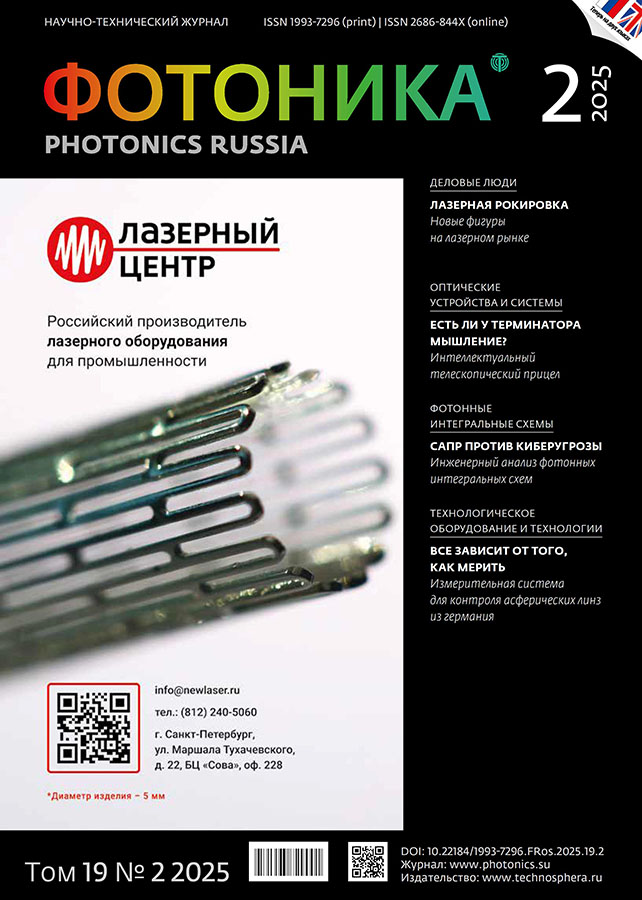Создание циклоадаптивного режима освещения для увеличения урожайности Lactuca sativa L.
- Авторы: Дегтерева М.М.1, Левин Е.В.1, Дегтерев А.Э.1, Ламкин И.А.1, Тарасов С.А.1
-
Учреждения:
- Санкт-Петербургский государственный электротехнический университет «ЛЭТИ» им. В. И. Ульянова (Ленина)
- Выпуск: Том 19, № 2 (2025)
- Страницы: 154-166
- Раздел: Биофотоника
- URL: https://journals.eco-vector.com/1993-7296/article/view/680351
- DOI: https://doi.org/10.22184/1993-7296.FRos.2025.19.2.154.166
- ID: 680351
Цитировать
Полный текст
Аннотация
В связи с необходимостью повышения урожайности растений и снижения энергопотребления источников излучения, мы вводим концепцию циклоадаптивного фоторежима (ЦАФР), который адаптируется к подстадиям (этапам) развития растений, динамически изменяет параметры освещения для оптимизации их роста и развития и способствует увеличению синтеза фотосинтетических пигментов. По результатам оценки влияния спектрального состава светодиодных устройств на развитие Lactuca sativa L. было определено, что светоизлучающее устройство, основанное на автоматизированном изменении спектрального состава излучения и плотности фотосинтетического фотонного потока в зависимости от этапа развития растения в соответствии с циклоадаптивной методикой освещения, приводит к увеличению урожайности культуры Lactuca sativa L. в 2 раза, а также снижению количества использованной воды, необходимой для образования 1 г сухого вещества, в 2,5 раза по сравнению с естественным освещением.
Полный текст
Об авторах
Мария Михайловна Дегтерева
Санкт-Петербургский государственный электротехнический университет «ЛЭТИ» им. В. И. Ульянова (Ленина)
Автор, ответственный за переписку.
Email: mmromanovich@etu.ru
ORCID iD: 0000-0001-6797-0595
ассистент кафедры фотоники
Россия, Санкт-ПетербургЕвгений Витальевич Левин
Санкт-Петербургский государственный электротехнический университет «ЛЭТИ» им. В. И. Ульянова (Ленина)
Email: e_levin@etu.ru
ORCID iD: 0009-0000-3811-487X
аспирант 2 года обучения
Россия, Санкт-ПетербургАлександр Эдуардович Дегтерев
Санкт-Петербургский государственный электротехнический университет «ЛЭТИ» им. В. И. Ульянова (Ленина)
Email: aedegterev@etu.ru
ORCID iD: 0000-0002-6151-6567
ассистент кафедры фотоники
Россия, Санкт-ПетербургИван Анатольевич Ламкин
Санкт-Петербургский государственный электротехнический университет «ЛЭТИ» им. В. И. Ульянова (Ленина)
Email: ialamkin@etu.ru
ORCID iD: 0000-0002-3680-7725
кандидат технических наук, доцент кафедры фотоники
Россия, Санкт-ПетербургСергей Анатольевич Тарасов
Санкт-Петербургский государственный электротехнический университет «ЛЭТИ» им. В. И. Ульянова (Ленина)
Email: satarasov@etu.ru
ORCID iD: 0000-0002-6321-0019
доктор технических наук, заведующий кафедрой фотоники
Россия, Санкт-ПетербургСписок литературы
- Al Murad M. et al. Light Emitting Diodes (LEDs) as Agricultural Lighting: Impact and Its Potential on Improving Physiology, Flowering, and Secondary Metabolites of Crops. Sustainability. 2021; 13(4): 1985. https://doi.org/10.3390/su13041985
- Hernández R., Kubota C. Physiological responses of cucumber seedlings under different blue and red photon flux ratios using LEDs. Environ Exp Bot. 2016; 121: 66–74. https://doi.org/10.1016/j.envexpbot.2015.04.001
- Sipos L. et al. Optimization of basil (Ocimum basilicum L.) production in LED light environments – a review. Sci Hortic. 2021; 289: 110486. https://doi.org/10.1016/j.scienta.2021.110486
- Viršilė A. et al. The Comparison of Constant and Dynamic Red and Blue Light Irradiation Effects on Red and Green Leaf Lettuce. Agronomy. 2020; 10(11): 1802. https://doi.org/10.3390/agronomy10111802
- Kamath D. et al. Dynamic versus Concurrent Lighting with Red and Blue Light-emitting Diodes as the Sole Light Source Can Potentially Improve Campanula Stock Plant Morphology for Cutting Production. HortScience. 2021; 56(11): 1439–1445. https://doi.org/10.21273/HORTSCI16034-21
- Nakonechnaya O. V. et al. In vitro potato plantlet development under different polychromatic LED spectra and dynamic illumination. Botanica Pacifica. 2021. https://doi.org/10.17581/bp.2021.10102
- Degtereva M. et al. Influence of the Spectral Composition of Illuminating Light Sources on Biometric and Phytochemical Characteristics of Ocimum basilicum L. Photonics. 2023; 10(12): 1369. https://doi.org/10.3390/photonics10121369
- Moustakas M., Calatayud Á., Guidi L. Editorial: Chlorophyll Fluorescence Imaging Analysis in Biotic and Abiotic Stress. Frontiers in Plant Science. Frontiers Media S. A. 2021; 12. https://doi.org/10.3389/fpls.2021.658500
- Solbach J.A., Fricke A., Stützel H. Compensation of adverse growing media effects on plant growth and morphology by supplemental LED lighting. PLoS One. Public Library of Science. 2023; 18(9). https://doi.org/10.1371/journal.pone.0291601
- Tabbert J.M., Schulz H., Krähmer A. Increased Plant Quality, Greenhouse Productivity and Energy Efficiency with Broad-Spectrum LED Systems: A Case Study for Thyme (Thymus vulgaris L.). Plants. 2021; 10(5): 960. https://doi.org/10.3390/plants10050960
- Hooks T. et al. Adding UVA and Far-Red Light to White LED Affects Growth, Morphology, and Phytochemicals of Indoor-Grown Microgreens. Sustainability. 2022; 14(14): 8552. https://doi.org/10.3390/su14148552
- Gao S. et al. Photosynthetic characteristics and chloroplast ultrastructure of welsh onion (Allium fistulosum L.) grown under different LED wavelengths. BMC Plant Biol. 2020; 20(1):78. https://doi.org/10.1186/s12870-020-2282-0
- Meng Q., Runkle E. S. Far-red radiation interacts with relative and absolute blue and red photon flux densities to regulate growth, morphology, and pigmentation of lettuce and basil seedlings. Sci Hortic. 2019; 255: 269–280. https://doi.org/10.1016/j.scienta.2019.05.030
- Degtereva M.M. et al. Assessment Procedure for the Advantages of LED Phyto-Strip Application in the Industrial Greenhouse Complexes. Photonics Russia. 2023; 17(7): 566–578. https://doi.org/10.22184/1993-7296.FRos.2023.17.7.566.578 Дегтерева М. М. и др. Методика оценки преимуществ применения светодиодной фитоленты в промышленных тепличных комплексах. Фотоника. 2023; 17(7): 566–578. https://doi.org/10.22184/1993-7296.FRos.2023.17.7.566.578
- GOST R 57671-2017. Irradiation devices with LED light sources for greenhouses. General specifications: GOST R 57671-2017. Russia: National Standard of the Russian Federation, 2017; 8. (In Russ.) ГОСТ Р 57671-2017. Приборы облучательные со светодиодными источниками света для теплиц. Общие технические условия: ГОСТ Р 57671-2017. Россия: Национальный стандарт Российской Федерации, 2017; 8.
- Luo X. et al. Improved estimates of global terrestrial photosynthesis using information on leaf chlorophyll content. Glob Chang Biol. 2019; 25(7): 2499–2514. https://doi.org/10.1111/gcb.14624
Дополнительные файлы












